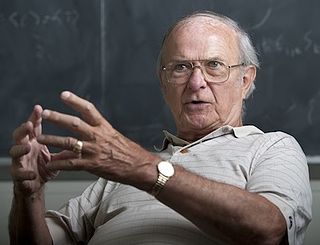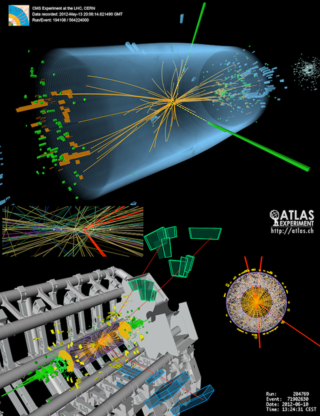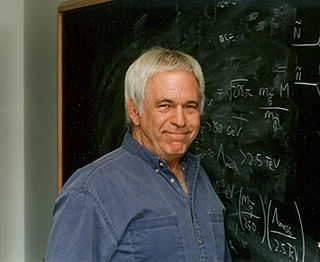
The multiverse is the hypothetical set of all universes. Together, these universes are presumed to comprise everything that exists: the entirety of space, time, matter, energy, information, and the physical laws and constants that describe them. The different universes within the multiverse are called "parallel universes", "flat universes", "other universes", "alternate universes", "multiple universes", "plane universes", "parent and child universes", "many universes", or "many worlds". One common assumption is that the multiverse is a "patchwork quilt of separate universes all bound by the same laws of physics."

The Standard Model of particle physics is the theory describing three of the four known fundamental forces in the universe and classifying all known elementary particles. It was developed in stages throughout the latter half of the 20th century, through the work of many scientists worldwide, with the current formulation being finalized in the mid-1970s upon experimental confirmation of the existence of quarks. Since then, proof of the top quark (1995), the tau neutrino (2000), and the Higgs boson (2012) have added further credence to the Standard Model. In addition, the Standard Model has predicted various properties of weak neutral currents and the W and Z bosons with great accuracy.
Supersymmetry is a theoretical framework in physics that suggests the existence of a symmetry between particles with integer spin (bosons) and particles with half-integer spin (fermions). It proposes that for every known particle, there exists a partner particle with different spin properties. There have been multiple experiments on supersymmetry that have failed to provide evidence that it exists in nature. If evidence is found, supersymmetry could help explain certain phenomena, such as the nature of dark matter and the hierarchy problem in particle physics.

In theoretical physics, the hierarchy problem is the problem concerning the large discrepancy between aspects of the weak force and gravity. There is no scientific consensus on why, for example, the weak force is 1024 times stronger than gravity.

Sir Thomas Walter Bannerman Kibble was a British theoretical physicist, senior research investigator at the Blackett Laboratory and Emeritus Professor of Theoretical Physics at Imperial College London. His research interests were in quantum field theory, especially the interface between high-energy particle physics and cosmology. He is best known as one of the first to describe the Higgs mechanism, and for his research on topological defects. From the 1950s he was concerned about the nuclear arms race and from 1970 took leading roles in promoting the social responsibility of the scientist.
In particle physics, little Higgs models are based on the idea that the Higgs boson is a pseudo-Goldstone boson arising from some global symmetry breaking at a TeV energy scale. The goal of little Higgs models is to use the spontaneous breaking of such approximate global symmetries to stabilize the mass of the Higgs boson(s) responsible for electroweak symmetry breaking.
In string theory, the string theory landscape is the collection of possible false vacua, together comprising a collective "landscape" of choices of parameters governing compactifications.

Jonathan Richard Ellis is a British theoretical physicist who is currently Clerk Maxwell Professor of Theoretical Physics at King's College London.

Physics beyond the Standard Model (BSM) refers to the theoretical developments needed to explain the deficiencies of the Standard Model, such as the inability to explain the fundamental parameters of the standard model, the strong CP problem, neutrino oscillations, matter–antimatter asymmetry, and the nature of dark matter and dark energy. Another problem lies within the mathematical framework of the Standard Model itself: the Standard Model is inconsistent with that of general relativity, and one or both theories break down under certain conditions, such as spacetime singularities like the Big Bang and black hole event horizons.

Gerald Stanford "Gerry" Guralnik was the Chancellor’s Professor of Physics at Brown University. In 1964 he co-discovered the Higgs mechanism and Higgs boson with C. R. Hagen and Tom Kibble (GHK). As part of Physical Review Letters' 50th anniversary celebration, the journal recognized this discovery as one of the milestone papers in PRL history. While widely considered to have authored the most complete of the early papers on the Higgs theory, GHK were controversially not included in the 2013 Nobel Prize in Physics.

Carl Richard Hagen is a professor of particle physics at the University of Rochester. He is most noted for his contributions to the Standard Model and Symmetry breaking as well as the 1964 co-discovery of the Higgs mechanism and Higgs boson with Gerald Guralnik and Tom Kibble (GHK). As part of Physical Review Letters 50th anniversary celebration, the journal recognized this discovery as one of the milestone papers in PRL history. While widely considered to have authored the most complete of the early papers on the Higgs theory, GHK were controversially not included in the 2013 Nobel Prize in Physics.

David B. Kaplan is an American physicist. He is a professor of physics at the University of Washington, where he was director of the Institute for Nuclear Theory during the period 2006–2016 and is now a senior fellow.

Christopher T. Hill is an American theoretical physicist at the Fermi National Accelerator Laboratory who did undergraduate work in physics at M.I.T., and graduate work at Caltech. Hill's Ph.D. thesis, "Higgs Scalars and the Nonleptonic Weak Interactions" (1977) contains one of the first detailed discussions of the two-Higgs-doublet model and its impact upon weak interactions.

The Higgs boson, sometimes called the Higgs particle, is an elementary particle in the Standard Model of particle physics produced by the quantum excitation of the Higgs field, one of the fields in particle physics theory. In the Standard Model, the Higgs particle is a massive scalar boson with zero spin, even (positive) parity, no electric charge, and no colour charge that couples to mass. It is also very unstable, decaying into other particles almost immediately upon generation.
The 1964 PRL symmetry breaking papers were written by three teams who proposed related but different approaches to explain how mass could arise in local gauge theories. These three papers were written by: Robert Brout and François Englert; Peter Higgs; and Gerald Guralnik, C. Richard Hagen, and Tom Kibble (GHK). They are credited with the theory of the Higgs mechanism and the prediction of the Higgs field and Higgs boson. Together, these provide a theoretical means by which Goldstone's theorem can be avoided. They show how gauge bosons can acquire non-zero masses as a result of spontaneous symmetry breaking within gauge invariant models of the universe.

Gordon Leon Kane is Victor Weisskopf Distinguished University Professor at the University of Michigan and director emeritus at the Leinweber Center for Theoretical Physics (LCTP), a leading center for the advancement of theoretical physics. He was director of the LCTP from 2005 to 2011 and Victor Weisskopf Collegiate Professor of Physics from 2002 - 2011. He received the Lilienfeld Prize from the American Physical Society in 2012, and the J. J. Sakurai Prize for Theoretical Particle Physics in 2017.
Raphael Bousso is a theoretical physicist and cosmologist. He is a professor at the Berkeley Center for Theoretical Physics in the Department of Physics, UC Berkeley. He is known for the Bousso bound on the information content of the universe. With Joseph Polchinski, Bousso proposed the string theory landscape as a solution to the cosmological constant problem.

Riccardo Rattazzi is an Italian theoretical physicist and a professor at the École Polytechnique Fédérale de Lausanne. His main research interests are in physics beyond the Standard Model and in cosmology.

Gavin Phillip Salam, is a theoretical particle physicist and a senior research fellow at All Souls College as well as a senior member of staff at CERN in Geneva. His research investigates the strong interaction of Quantum Chromodynamics (QCD), the theory of quarks and gluons.

Tsutomu Yanagida is a Japanese physicist who first proposed the seesaw mechanism in 1979 and developed the model of leptogenesis. The name of the seesaw mechanism was given by him in a Tokyo conference in 1981. In 1994, he predicted, together with M. Fukugita, the nonzero cosmological constant Λ = (3 ± 1 meV)4 four years prior to the observation in order to resolve the age discrepancy between the Universe and some old stars.














